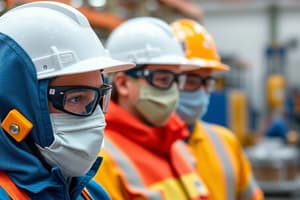Podcast
Questions and Answers
Why is personal protective equipment (PPE) essential in industries?
Why is personal protective equipment (PPE) essential in industries?
- To increase the weight of workers' uniforms
- To enhance the appearance of workers
- To speed up the work processes
- To protect individuals from injuries, diseases, and fatalities (correct)
What are some common fields that require the use of personal protective equipment (PPE)?
What are some common fields that require the use of personal protective equipment (PPE)?
- Entertainment and hospitality
- IT and software development
- Construction, healthcare, manufacturing, and agriculture (correct)
- Food and beverage industry only
What are the consequences of not using PPE according to OSHA?
What are the consequences of not using PPE according to OSHA?
- Less likely to get injured
- 3 times more likely to experience an illness and 5 times more likely to experience a work-related injury (correct)
- No difference in risk levels compared to using PPE
- No consequences at all
How can the use of personal protective equipment (PPE) prevent long-term health effects?
How can the use of personal protective equipment (PPE) prevent long-term health effects?
Which type of Personal Protective Equipment (PPE) includes masks and respirators?
Which type of Personal Protective Equipment (PPE) includes masks and respirators?
What does Protective Clothing mainly protect against?
What does Protective Clothing mainly protect against?
What are some benefits of using Personal Protective Equipment (PPE) according to the text?
What are some benefits of using Personal Protective Equipment (PPE) according to the text?
How does the use of PPE impact worker productivity according to the text?
How does the use of PPE impact worker productivity according to the text?
What is one way in which PPE contributes to reducing costs in organizations?
What is one way in which PPE contributes to reducing costs in organizations?
Which standards must PPE products comply with for effectiveness and reliability?
Which standards must PPE products comply with for effectiveness and reliability?
How does compliance with standards ensure the effectiveness of PPE products?
How does compliance with standards ensure the effectiveness of PPE products?
What role does personal protective equipment (PPE) play in ensuring the health and safety of workers?
What role does personal protective equipment (PPE) play in ensuring the health and safety of workers?
Flashcards are hidden until you start studying
Study Notes
Importance of Personal Protective Equipment (PPE)
Personal protective equipment (PPE) is essential in many industries where workers are exposed to hazardous materials, infectious diseases, physical threats, or other dangers that could potentially cause harm. These risks are common in various fields such as construction, healthcare, manufacturing, agriculture, law enforcement, and waste management. The importance of PPE lies in its ability to protect individuals from injuries, diseases, and fatalities.
Risks and Hazards
The risks associated with not using PPE are significant. According to the Occupational Safety and Health Administration (OSHA), workers who do not use PPE are 3 times more likely to experience a work-related injury and 5 times more likely to experience an illness. Additionally, the use of PPE can prevent long-term health effects such as chronic obstructive pulmonary disease (COPD) from inhaling hazardous dusts, or skin diseases from handling chemicals.
Types of PPE
There are various types of PPE designed to protect against different hazards:
- Respiratory Protection: Includes masks, respirators, and other devices that filter out hazardous airborne particles or gases.
- Head, Eye, Face, and Ear Protection: Protects against particles, chemicals, harmful radiation, or other hazards.
- Protective Clothing: Covers the entire body or specific body parts to protect against heat, cold, electricity, chemicals, or other hazards.
- Hand Protection: Includes gloves made of materials such as rubber, metal-mesh, or leather to protect against cuts, abrasions, burns, chemicals, electricity, or other hazards.
- Foot Protection: Includes protective shoes designed to protect against impact, compression, punctures, or other hazards.
Benefits of Using PPE
The benefits of using PPE include reduced injuries, illnesses, fatalities, and costs associated with workplace accidents:
- Increased Productivity: When workers feel secure knowing they are protected, they perform better and are less distracted by safety concerns.
- Reduced Workers' Compensation Claims and Insurance Premiums: Organizations that demonstrate a strong commitment to worker safety often enjoy lower insurance premiums.
- Morale Boost: Employees appreciate when their employer takes care of them and provides equipment necessary for safe work.
Standardization and Compliance
To ensure effectiveness, PPE products must comply with various standards set by organizations like OSHA, European Committee for Electrotechnical Standardization (CE), American Society for Testing and Materials (ASTM), and National Institute for Occupational Safety and Health (NIOSH). Adherence to these standards ensures workout performance consistency, reliability, durability, and effectiveness under various conditions.
In conclusion, personal protective equipment plays a critical role in ensuring the health and safety of individuals who work in environments with potential hazards. By understanding the importance of PPE and following standard procedures, organizations can create a safer work environment for all employees.
Studying That Suits You
Use AI to generate personalized quizzes and flashcards to suit your learning preferences.




